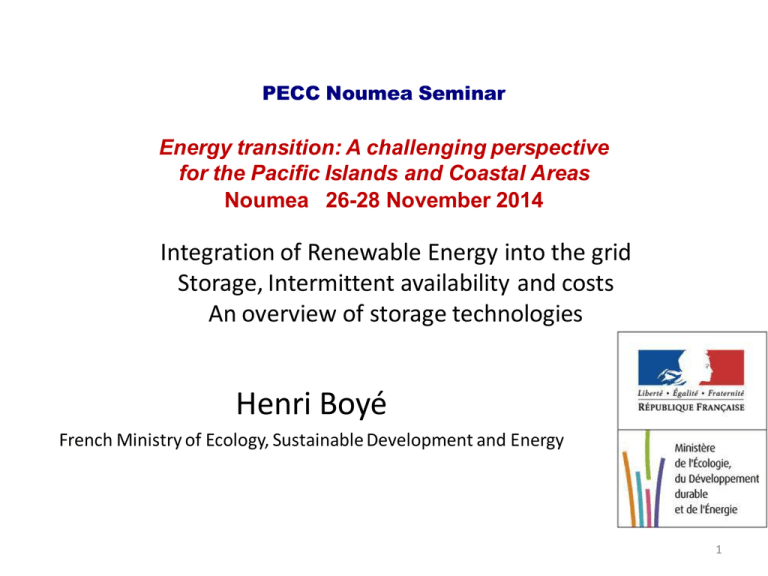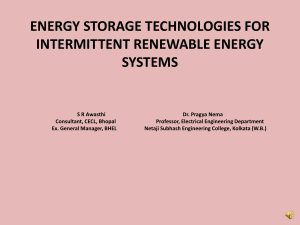Electric Energy Storage
advertisement

PECC Noumea Seminar Energy transition: A challenging perspective for the Pacific Islands and Coastal Areas Noumea 26-28 November 2014 Integration of Renewable Energy into the grid Storage, Intermittent availability and costs An overview of storage technologies Henri Boyé French Ministry of Ecology, Sustainable Development and Energy 1 A basket of solutions for Islands In Isolated electric systems, no more then 30% of intermittent RES power without back-up or storage Use islands as a priority test-bed, for innovative technologies, such as RES, storage, smart grids. 2 ENERGY STORAGE TECHNOLOGIES FOR INTERMITTENT RENEWABLE ENERGY SYSTEMS • The development of renewable energy, mostly intermittent, (photovoltaic, wind) optimizing power generation and the development of portability require breakthrough innovations in storage systems. • It is an indispensable element of any successful energy transition. • The storage of energy is a necessity for a better use of intermittent energy and facilitate the mobility of tomorrow. 3 Background of storage system • In any electrical system, energy exchanges are just in real time, thanks to a continuous real-time management of production that are aligned with the energy demand to maintain the network equilibrium flows. Storage is one of the techniques used to achieve this balance. • Electric Energy Storage is mostly used to transfer energy from off-peak time, to peak-time, with a valorization. For renewable energy, It can store unstable electric energy during wind and photovoltaic power generation, and supply this energy to the electric power system again, in necessary moment 4 Background of storage system Energy Storage is mostly used to transfer energy from off-peak time, to peak-time, with a valorization. Load (MW) Time (Hr) 5 Energy storage a challenging and costly process • Electricity can only be stored by conversion into other forms of energy (e.g. potential, thermal, chemical or magnetic energy). • Grids must be balanced exactly in real time, and we must ensure that the cost of electricity is the lowest possible. • Storage of electricity has many advantages, • in centralized mass storage used for the management of the transmission network, • or decentralized storage of smaller dimension. 6 An overview of storage technologies • We present : mechanical storage in hydroelectric and pumped storage power stations, compressed air energy storage (CAES), flywheels accumulating kinetic energy, • electrochemical batteries with various technologies, traditional lead acid batteries, lithium ion, sodium sulfur (NaS) and others, including vehicle to grid, sensible heat thermal storage, • superconducting magnetic energy storage (SMES), • super capacitors, • conversion into hydrogen... 7 Hydropower Gravity and Pumping storage • The pumped storage is a proven technology of hydropower, known since the late 19th century. • A pumped storage hydro power plant may store huge energy by pumping water from a lower reservoir to a higher pond. • In a pumped storage hydro plant, Water is pumped during off-peak times and may be utilized to generate electricity. Other innovations may store electricity in small quantity but pumped storage hydro power plant may store electricity in Megawatts (MW) or even ) Gigawatts(GW. 8 Marine Pumping Storage Pumped Storage Plants can also be installed coastline, with the sea as bottom reservoirt and an upstream resrvoir on top of a cliff or formed by a dam. There is now a marine STEP in Okinawa, Japan, and projects n France Reunion, Guadeloupe and Martinique islands, and in Morrocco. 9 Okinawa Japan Pumping storage Hydroelectric power station located in Kunigami, Okinawa Japan The world’s first pumped-storage to use seawater for storing energy. Its maximum output is 30 MW. Projects in Guadeloupe and Réunion Island… El Hierro Canary Island The first island in the world to be fully powered by wind and water, Uses hydroelectric power (11,3MW) during lowwind periods, and wind farms provide the power required to pump water back into the reservoir located in a volcanic crater 700 meters above sea level. 11 CAES Compressed air energy storage •In CAES Air is compressed offpeak by a turbocharger coupled to a gas turbine and is stored in underground cavities •Energy from solar or wind and even electricity from thermal power plant during off-peak period may be utilized to compress air by compressor and same air may be utilized to produce electricity during peak-hour. 12 CAES : Compressed Air Energy storage 13 CAES in operation • The CAES are experienced since 1979 in Germany and the USA • - In Germany near Bremen the CAES plant at Huntorf delivers 290 MW with a range of two hours, with air stored at 70 bars in two salt caverns of 310,000 m3 within 500 m of depth. A second application from the development of wind power in Northern Germany is used to compensate for variations of this resource in order to provide a more stable power. • - In the USA, the largest project of CAES in the world is at Norton (near Cleveland, Ohio). Its power is about 2700 MW, with nine production units (compressors - turbine) operating with compressed air at 110 bar. The storage tank is a cave in limestone quarries at 570 m depth. • This project is currently delayed because of shale gas low cost in USA and lack of competitiveness 14 Spinning flywheel Flywheels Graciosa (Azores Islands) Power store Flywheel Grid stabilizing generator. Its main purpose is to stabilize power systems against fluctuations in frequency and voltage. 15 Flywheel energy storage • A flywheel stores electrical energy as kinetic energy through the rotation of a heavy mass, to reach very high speeds (> 8000 rev / min) in some minutes. To store energy , an electric motor accelerates a Disk ; To use the stored energy in the rotor, a generator converts mechanical energy to electrical energy. The system performance is optimized through the magnetic bearings and vacuum containment . We distinguish flywheels slow (hard steel ) and rapid ( composite discs ) The flywheel system is a very efficient energy storage device, it can be used for various applications. Systems storage flywheel have a very high reactivity and durability . They can absorb very high power variations on very large numbers of cycles. Flywheel systems can store more energy per system weight compared to chemical batteries 16 Electrochemical batteries An early solution to the problem of storing energy for electrical purposes was the development of the battery as an electrochemical storage device. Batteries have previously been of limited use in electric power systems due to their relatively small capacity and high cost. Electrochemical batteries with various technologies, traditional lead acid batteries, lithium ion, sodium sulfur (NaS) and others 17 HELION 17 Sodium Sulfur Battery Diagram of the sodium-sulfur components and their assembly into battery. Source: NGK Insulator . NGK develops sodium–sulfur batteries as grid storage in Japan, France (Île de la Réunion) The battery sodium - sulfur ( NaS ) works with liquid electrodes and must be maintained at a temperature between 290°C and 350° C. The rankings of various types of batteries in terms of cost and availability of basic materials frequently classify the couple sodium-sulfur No. 1 in all categories. SMES Superconducting magnet energy storage Superconducting magnetic energy storage systems (or SMES) store energy in the magnetic field created by the flow of direct current in a superconducting coil. This advanced systems store energy within a magnet and release it within a fraction of a cycle. The facilities are mainly pilot demonstration, with the beginning of industrialization. S M E S Superconducting Magnetic Energy Storage with cryogenic refrigerator 20 Super Capacitor Appeared in the 2000s , super- capacitors are dedicated components to power storage rather than the energy . Maxwell Products super capacitors 21 High Temperature Thermal Storage CSP Concentrated Solar Power Storage by Molten Salts 22 CSP Energy Storage • Concentrated Solar Power (CSP) uses molten salt to store solar power and then dispatch that power as needed. The system pumps molten salt through a tower heated by the sun's rays. Insulated containers store the hot salt solution, and when needed water is then used to create steam that is fed to turbines to generate electricity. 23 Hydrogen Energy Storage • Hydrogen is also being developed as an electrical power storage medium. Hydrogen is not a primary energy source, but a portable energy storage method, because it must first be manufactured by other energy sources in order to be used. However, as a storage medium, it may be a significant factor in using renewable energies, with a very high energy density. • These technologies are very promising. But for now , they suffer from several drawbacks : low efficiency of the process is at best about 30 % , a high price , limited power and low life of electrochemical generators . R & D works are still in progres. 24 Hydrogen storage MYRTE Corsica 25 Regenerative fuel cell storage • A fuel cell is a device that generates electricity by a chemical reaction (from combustible substances such as hydrogen, methane, propane, and methanol) into an electric current. • Every fuel cell has two electrodes, one positive and one negative, called, respectively the anode and cathode. • Hydrogen is the basic fuel, but fuel cells also require oxygen. • Fuel cells generate electricity with very little pollution. 26 Vehicle to Grid scheme integration of electric vehicles with renewables and the future ‘intelligent’ grid 27 Electric bikes & scooters An example of electric bike, at Paris La Défense Henri Boyé Electric scooter 28 • Some conclusions on energy storage • Which storage technology can make the transition happen? • How much will it cost ? • The different technologies for energy storage are compared in terms of their cost and level of maturity. The technologies are not all at the same level today of technological maturity. • We reproduce a summary table of the maturity of key technologies for stationary electricity storage (source ENEA Consulting) . • The investment costs are provided for information only, with still significant uncertainties , given the still emerging nature of the sector and the lack of feedback 29 Energy storage Technological readiness level The different technologies for energy storage are compared in terms of their cost and level of maturity We reproduce a summary table of the maturity of key technologies for stationary electricity storage (source ENEA Consulting) . 30 French Isolated Insular Electric systems 31 RES and storage in Islands • Islands as a challenge, and an opportunity for demonstrating energy solutions • Improve security of supply through diversified power generation technologies • Use islands as a priority test-bed, for innovative technologies, such as RES, storage, smart grids. • Foster R&D on islands, • Towards an island action plan 2020-2030 ?? 32

